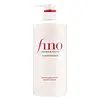What's inside
What's inside
 Key Ingredients
Key Ingredients

No key ingredients
 Benefits
Benefits

 Concerns
Concerns

 Ingredients Side-by-side
Ingredients Side-by-side

Water
Skin ConditioningSodium Laureth Sulfate
CleansingSodium Cocoamphoacetate
CleansingSodium Methyl Cocoyl Taurate
CleansingDipropylene Glycol
HumectantGlycol Distearate
EmollientCocamide Mea
EmulsifyingSorbitol
HumectantDimethicone
EmollientSodium Chloride
MaskingPCA
HumectantHydrolyzed Wheat Protein
Skin ConditioningPolyquaternium-64
Hydrolyzed Silk Gland Powder
HumectantRoyal Jelly Extract
Skin ConditioningCitric Acid
BufferingCassia Hydroxypropyltrimonium Chloride
Sodium Methyl Lauroyl Taurate
CleansingSodium Edtmp
Butylene Glycol
HumectantPotassium Sorbate
PreservativeSodium Benzoate
MaskingPhenoxyethanol
PreservativeSodium Paraben
PreservativeParfum
MaskingWater, Sodium Laureth Sulfate, Sodium Cocoamphoacetate, Sodium Methyl Cocoyl Taurate, Dipropylene Glycol, Glycol Distearate, Cocamide Mea, Sorbitol, Dimethicone, Sodium Chloride, PCA, Hydrolyzed Wheat Protein, Polyquaternium-64, Hydrolyzed Silk Gland Powder, Royal Jelly Extract, Citric Acid, Cassia Hydroxypropyltrimonium Chloride, Sodium Methyl Lauroyl Taurate, Sodium Edtmp, Butylene Glycol, Potassium Sorbate, Sodium Benzoate, Phenoxyethanol, Sodium Paraben, Parfum
Water
Skin ConditioningCetearyl Alcohol
EmollientBenzyl Alcohol
PerfumingOlea Europaea Fruit Oil
MaskingSimmondsia Chinensis Seed Oil
EmollientOleyl Alcohol
EmollientDaucus Carota Sativa Root Extract
Skin ConditioningStearamidopropyl Dimethylamine
EmulsifyingCitric Acid
BufferingLactic Acid
BufferingBenzophenone-9
UV AbsorberHydrolyzed Collagen
EmollientDi-C12-18 Alkyl Dimonium Chloride
Skin ConditioningPanthenol
Skin ConditioningBenzyl Glycol
SolventEthylhexylglycerin
Skin ConditioningRaspberry Ketone
MaskingGlycerin
HumectantOctyldodeceth-20
CleansingOctyldodeceth-16
EmulsifyingParfum
MaskingBenzyl Salicylate
PerfumingCinnamyl Alcohol
PerfumingCitronellol
PerfumingGeraniol
PerfumingHexyl Cinnamal
PerfumingHydroxycitronellal
PerfumingWater, Cetearyl Alcohol, Benzyl Alcohol, Olea Europaea Fruit Oil, Simmondsia Chinensis Seed Oil, Oleyl Alcohol, Daucus Carota Sativa Root Extract, Stearamidopropyl Dimethylamine, Citric Acid, Lactic Acid, Benzophenone-9, Hydrolyzed Collagen, Di-C12-18 Alkyl Dimonium Chloride, Panthenol, Benzyl Glycol, Ethylhexylglycerin, Raspberry Ketone, Glycerin, Octyldodeceth-20, Octyldodeceth-16, Parfum, Benzyl Salicylate, Cinnamyl Alcohol, Citronellol, Geraniol, Hexyl Cinnamal, Hydroxycitronellal
Ingredients Explained
These ingredients are found in both products.
Ingredients higher up in an ingredient list are typically present in a larger amount.
Citric Acid is an alpha hydroxy acid (AHA) naturally found in citrus fruits like oranges, lemons, and limes.
Like other AHAs, citric acid can exfoliate skin by breaking down the bonds that hold dead skin cells together. This helps reveal smoother and brighter skin underneath.
However, this exfoliating effect only happens at high concentrations (20%) which can be hard to find in cosmetic products.
Due to this, citric acid is usually included in small amounts as a pH adjuster. This helps keep products slightly more acidic and compatible with skin's natural pH.
In skincare formulas, citric acid can:
While it can provide some skin benefits, research shows lactic acid and glycolic acid are generally more effective and less irritating exfoliants.
Most citric acid used in skincare today is made by fermenting sugars (usually from molasses). This synthetic version is identical to the natural citrus form but easier to stabilize and use in formulations.
Read more about some other popular AHA's here:
Learn more about Citric AcidParfum is a catch-all term for an ingredient or more that is used to give a scent to products.
Also called "fragrance", this ingredient can be a blend of hundreds of chemicals or plant oils. This means every product with "fragrance" or "parfum" in the ingredients list is a different mixture.
For instance, Habanolide is a proprietary trade name for a specific aroma chemical. When used as a fragrance ingredient in cosmetics, most aroma chemicals fall under the broad labeling category of “FRAGRANCE” or “PARFUM” according to EU and US regulations.
The term 'parfum' or 'fragrance' is not regulated in many countries. In many cases, it is up to the brand to define this term.
For instance, many brands choose to label themselves as "fragrance-free" because they are not using synthetic fragrances. However, their products may still contain ingredients such as essential oils that are considered a fragrance by INCI standards.
One example is Calendula flower extract. Calendula is an essential oil that still imparts a scent or 'fragrance'.
Depending on the blend, the ingredients in the mixture can cause allergies and sensitivities on the skin. Some ingredients that are known EU allergens include linalool and citronellol.
Parfum can also be used to mask or cover an unpleasant scent.
The bottom line is: not all fragrances/parfum/ingredients are created equally. If you are worried about fragrances, we recommend taking a closer look at an ingredient. And of course, we always recommend speaking with a professional.
Learn more about ParfumWater. It's the most common cosmetic ingredient of all. You'll usually see it at the top of ingredient lists, meaning that it makes up the largest part of the product.
So why is it so popular? Water most often acts as a solvent - this means that it helps dissolve other ingredients into the formulation.
You'll also recognize water as that liquid we all need to stay alive. If you see this, drink a glass of water. Stay hydrated!
Learn more about Water